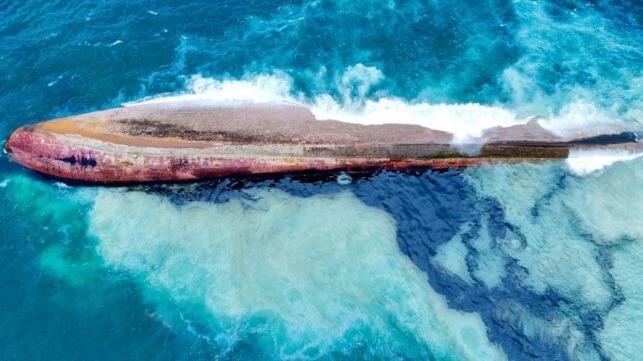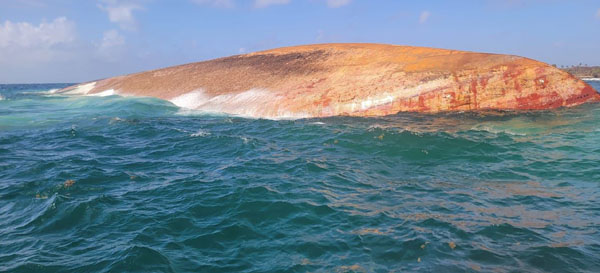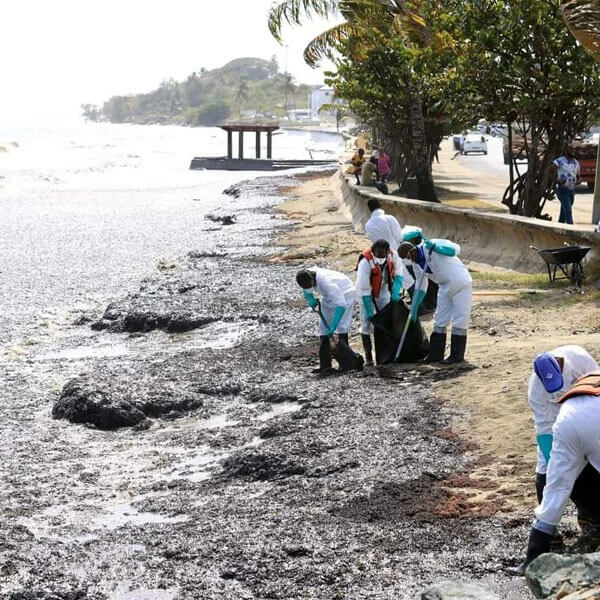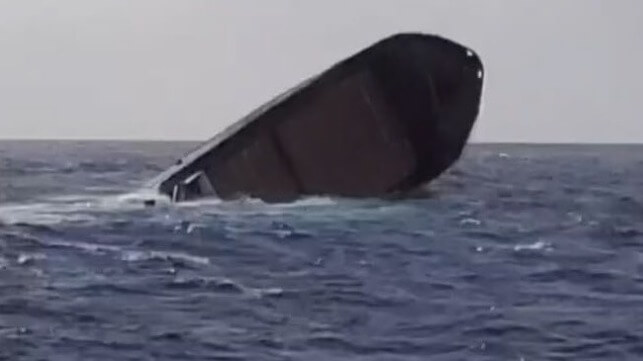ECOCIDE
Mysterious Capsized Cargo Ship Causes Oil Spill Emergency in Tobago

Officials on the Caribbean island of Tobago are scrambling to clean up a growing oil spill while they also investigate the mysterious capsized vessel that is causing the growing environmental disaster. Oil is fouling the southwestern end of the island with warnings that it may continue to spread.
A massive clean-up effort has been launched as the oil continues to wash onshore with the Trinidad & Tobago Coast Guard investigating the vessel. The government is now classifying it as a Tier II disaster with the Tobago Emergency Management Agency (TEMA), Environmental Management Authority, and other government agencies all coordinating in the effort. Speculation was that it would be elevated to a Tier III disaster by the end of the day Thursday or early on Friday.
The incident began on Wednesday, February 7, when the authorities received reports of a capsized vessel. They noted that there had been no distress call and a subsequent search has failed to turn up the crew either on board or having escaped from the sinking ship. Oil from the vessel quickly began to reach the shoreline.

Oil is continuing to leak from the capsized cargo ship (TEMA)
Divers were sent to examine and identify the vessel reporting back a visual identity as Gulfstream but so far they have been unable to identify any registration information. Efforts to get to a possible registration number on the stern were being blocked by the ongoing oil leak. The vessel's visible name does not correspond with international ship registries.
They are estimating the vessel’s length at 330 feet (100 meters) and they believe it was transporting lumber and sand. The divers reported that there appears to also be damage to the nearby reef and that portions of the vessel’s superstructure detached and may lie in a debris field.
They found no signs of life aboard the vessel, although further searches of the debris were planned. The speculation is that the vessel might have been abandoned and left to sink. The trail of damage suggests the ship drifted into the cove from the south and may have dragged along the bottom before coming to rest. Some observers are saying they saw the vessel as early as Tuesday.

Crews worked through the day on Thursday and late into the night reporting that their focus is on containment and they have deployed protective booms. The port in Scarborough they are reporting so far remains oil free while testing is ongoing to confirm their suspicions that diesel oil is leaking from the ship.
Along the beaches, 67 people are reported to be working to clean up the oil while government officials are warning the public to stay away from southwest Tobago. One of the big concerns is that the oil will contaminate fish and the food supply.
Aging Freighter Sank Under Tow Due to Engine Room Flooding

When the crew of the tug Capt. Beau set out to tow a derelict cargo ship from Miami to Haiti, they were in for an unwelcome surprise. Just about everything that could go wrong did go wrong: in rough seas, the towed ship payed out its own anchor, broke loose from the bridle, took on water and sank by the stern.
The ship in question was an aging 270-foot freighter, the Carib Trader II. The vessel was pushing 50 years old, and was not in perfect shape; she had a long history of inspection deficiencies, and had previously been found carrying cocaine. She was detained at Miami in November 2020 for a range of safety issues, and she stayed there for more than a year while arrangements were made for repairs.
In February 2022, the owner arranged to tow Carib Trader II to Haiti, where the vessel would be repaired. The ship was surveyed above the waterline before departure, and the Coast Guard signed off on the tow plan.
Capt. Beau set up a tow with a bridle of Spectra, chain and wire rope, rigged to the freighter's mooring bits. They got under way and headed south for the Old Bahama Channel.
On March 6, as they were under way off the coast of Cuba, the weather was on the rough side of what the tow plan allowed for. Winds were at up to 30 knots and seas were 7-9 feet. At about 0035 hours, the mate heard a bang, and the tug sped up on its own. The mate suspected that the tow might have parted, and he woke the captain, who took over the watch. The rest of the crew pulled in the tow line and found that both legs of the Spectra line bridle had parted.
In the dark, the Capt. Beau maneuvered to recover the tow. At about 0140, the crew noticed that the Carib Trader's port anchor had payed out and was suspended in the water column. Ominously, the freighter was also trimmed by the stern.
The crew rigged a tow by reconnecting to the remains of the bridle on the port side, and they resumed the tow at low speed, planning to investigate further after daybreak.
At about 0720, the mate went aboard the Carib Trader to investigate. He found that the engine room was flooded and that the water had already risen above the main engine. At the captain's direction, the mate started up a portable dewatering pump and rigged it to pump the water over the side.
The situation did not improve, and by 1100, the mate determined that the pump was not keeping up with the rate of flooding. By 1500, the Carib Trader began listing to starboard, and it became clear that the vessel would sink. The mate got off the vessel, and the captain had the engineer cut the tow wire free. Carib Trader II went to the bottom in 3,300 feet of water at about 1620.
Based on the available information and the Carib Trader's "substandard" maintenance history, NTSB determined that the likely cause of the sinking was an unidentified leak in the engine room below the waterline. The freighter had not been drydocked in years, and the condition of the hull was unknown.
As for the parted bridle, the surface conditions at the time of the casualty were at the allowable limits of the tow plan, and would have placed stress on the towline. NTSB assessed that two unexpected sources of drag - the trailing anchor and the increasing draft of the Carib Trader's stern - further increased the strain, raising the odds that some component would part in the 7-9 foot seas.


No comments:
Post a Comment